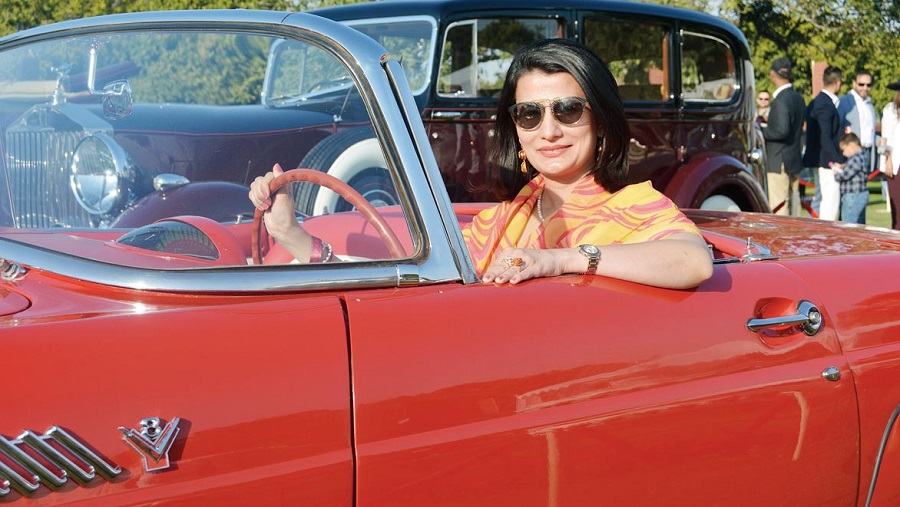Indore-based Vidita Singh comes from the family of the erstwhile royals of Barwani in Madhya Pradesh. Possibly the first artist in India to focus exclusively on cars, she is now a veteran of numerous solo as well as group shows in India and abroad. An invited member of the American website AutomotiveArtist.com, she has also been acclaimed by in the Dutch website Carartspot.com and been the guest exhibiting artist at the Automotive Fine Arts Society Exhibition at Pebble Beach Concours, California, in 2018. Vidita tells t2oS what drives her passion for her art. Excerpts.
While automotive art is a popular genre abroad, you are the first artist in India who dedicated himself or herself fully to it. How did the idea of doing that come to you?
I have grown up in a car-loving family. My grandfather was very fond of cars. He was always buying and selling cars. It was like a big hobby for him. And my father and uncles turned this hobby into their profession. So, I have been around vintage and classic cars all my life. There are car books at home and conversations at dinner tables revolving around cars. So it was me amalgamating two of my passions — for art and for cars — together. And there was my father’s encouragement for me. Maybe he saw some talent in me. There were, at that point definitely, American and European artists who were doing it, but in India it wasn’t even that well-known.
So when did you take up automotive art?
This was around the late 1990s I would say. I was also exposed to that kind of art. Even I liked cars and thought I could do something like this. So it started from there and went on to trying to get some Indianness into it, the Indian aspect of the automotive culture.
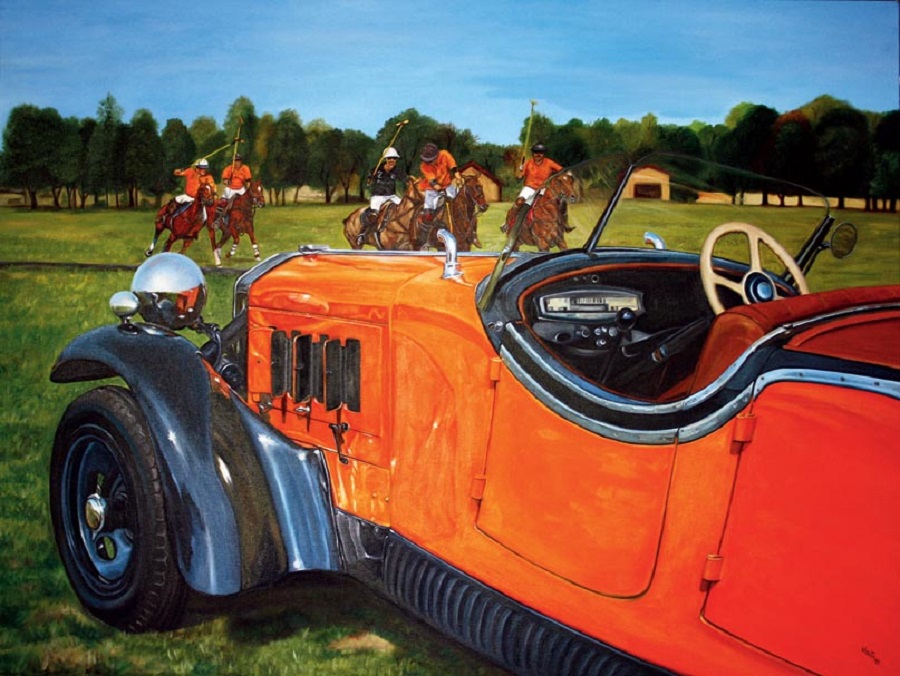
Lancia at the polo match Pictures courtesy: Vidita Singh
Much of your art shows foreign cars and fairly expensive ones at that, but in India…
It is by intention. I got into it trying to capture the history of automobile culture in India. One of the first ideas, and it is one that still runs through a lot of my work, was to show what these cars were like in their heyday. What was the feeling around them. Like I did this series around animals. Most of the roads then would go through jungles or villages. So there was this encounter with a bullock cart. There was this huge Rolls-Royce that was in front of the bullocks, which had never seen anything like it before. And they were startled by it. So you know it was these kinds of stories that I had heard from my father and uncles and grandfather that I wanted to get on canvas. That was the main idea.
And I also wanted to show how (The context. - Ed.) the cars were in India. I wanted to show that as well. Usually it was exotic cars because we are all enamoured by them and these are mostly cars that were brought in by the maharajas at that point. So the settings are palaces or polo matches and things like that for most of my paintings. So even if you hadn’t seen the cars in those settings you had heard about the stories from people. That comes from my family background where I got to hear how these cars were driven and how they were kept and so on, and who owned them. All that was a big interest of my life.
Most of the cars that you paint more or less span the 1920s to the 1950s. Why’s that?
Yeah, yeah. I like the cars from the 1930s and the cars from the 1950s. The 1940s is a bit shaky. So the early Thirties would be Art Deco and then the 1950s would be American Golden Age.
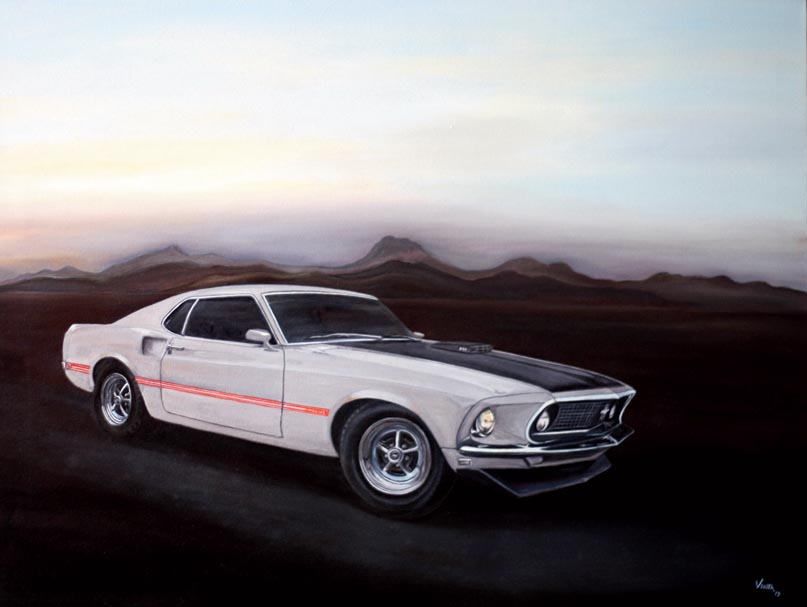
Mustang with the Satpura range Pictures courtesy: Vidita Singh
Any favourites among your paintings?
You can never ask that because if it becomes a favourite you don’t want to part with it. But that said, I think I really like the way I managed to put the encounter with the bullock cart, I got a very different perspective there and captured a very poignant moment. Then I am enjoying doing the parts of the cars, like only the headlights, larger than life headlights of the Minerva, then the Lagonda that I did with the polo scene, with a very different angle than the usual. It’s usually the bang-on front of the car that draws me to it, or it’s some weird angle that you wouldn’t think of putting in a picture. But that is my challenge. I like to take it up.
Or show something from an unusual angle. Like I did one car from the top. It was a boat tail Rolls-Royce and the shape came out really well of the boat tail because it was from the top.
Tell us a little about your art training…
I am not very formally trained in art, but did have tutors and did art classes, but I did not do a master’s or a fine arts degree. In fact, actually I am glad that I didn’t go through formal art training in school or college. I have managed to learn the techniques through short courses or whatever, but if I had done a very formal course, I might have felt restricted… taught to think in a certain way. So I am quite happy. I mean I have done art appreciation, art history and art restoration, basically everything related to art but the fine art degree.
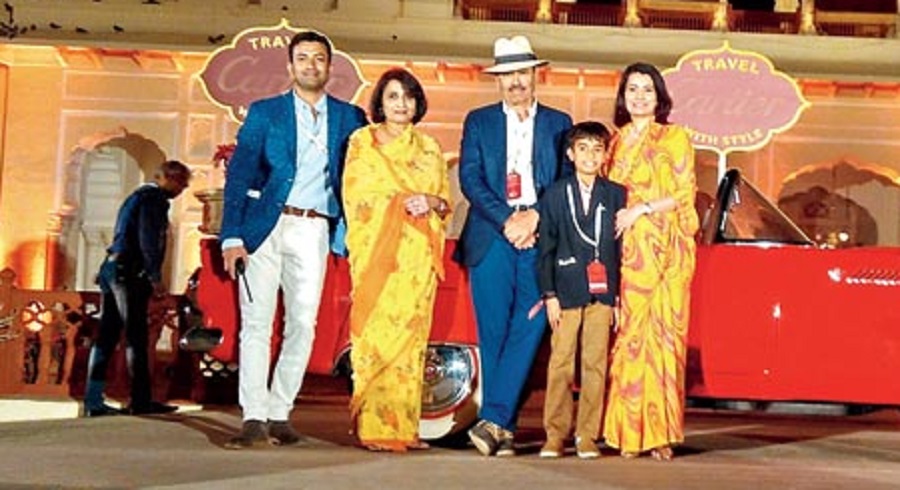
Vidita Singh (extreme right) with her father Manvendra Singh (in hat) and family members Pictures courtesy: Vidita Singh
Automotive art is a bit of a unique genre where it is often difficult to get the proportions and shapes right, unlike other subjects. But you did not go through any formal training in this particular area?!
No, no, um, no, I didn’t. Whatever training I got was from my dad (Manvendra Singh is an automotive historian and one of India’s best-known car restorers), who would also render and do perspectives. So when you’re painting on cars, or if you are building a car from scratch, from metal and wood, it also requires a great deal of idea of perspective. So that idea of perspective was taught and honed in me, you know, how you get the angle right and so on. So that’s how I have honed it myself as well.
So your earliest car pictures,how far back would those be?
Cars I would be drawing as a kid also, but those are not very proportionate. I actually got a prize for a painting of a street scene with cars and buses in school. So, basically, then you are doing other art forms and drawing other things as well. So there were horses, I was doing paintings of horses. I actually started seriously on automotive art in college, when I would be back home for the holidays I would be mostly sitting and painting at home.
You have painted cars in various settings and stills and in motion. Can you take us through the process of creating your art?
First I start with the car that I want to paint — could be a Rolls-Royce or a Bentley or any other marque — and then depending on the story around it or what it represents — if it’s speed, or maybe it actually has a feminine angle, or I am enamoured by a certain view, or the lights or the fenders. So I might take up just that part of the car and not the whole thing. Like one of my earlier works was a Buick at the shikar, which shows the car wading through water. This also was based on a story that I had heard and some reference pictures of cars wading through water. So then I made this painting.
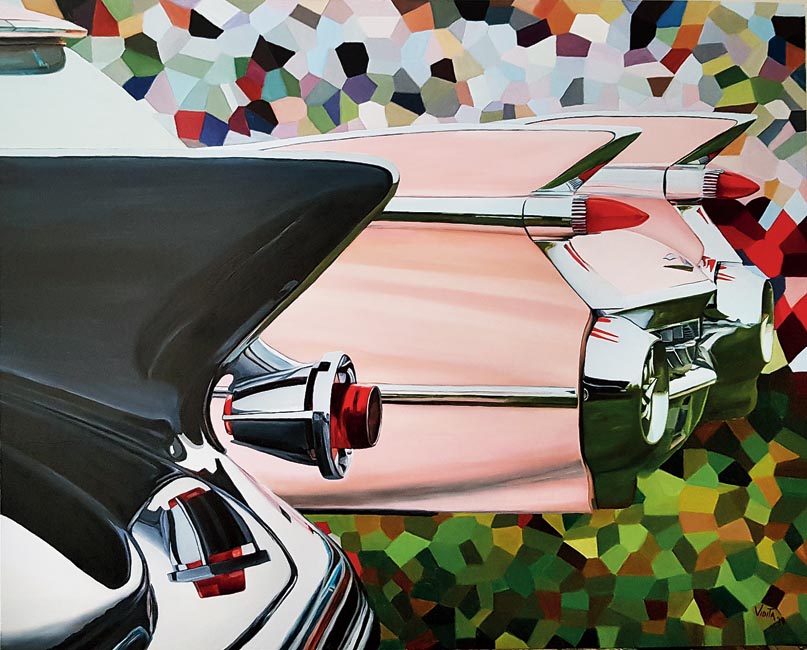
Tail light rhapsody Pictures courtesy: Vidita Singh
Who are the automotive artists that you look up to? Do you have any favourites?
There are quite a few artists actually. There’s William A. Motta, he was a very, very senior automotive artist. Then you have the American Automotive Fine Arts Society. There are certain French artists also who are quite inspiring, like Alain Levesque.
Talking about automotive art in popular culture, the representation of cars in Tintin comics is also very accurate. Any inspiration from there?
I did read a lot of Tintin comics. But as for inspiration, I would not know. Maybe the storytelling…. Actually, I am quite inspired by Indian artists like Raja Ravi Varma for the way he did his oil paintings and the way he used to use detail.
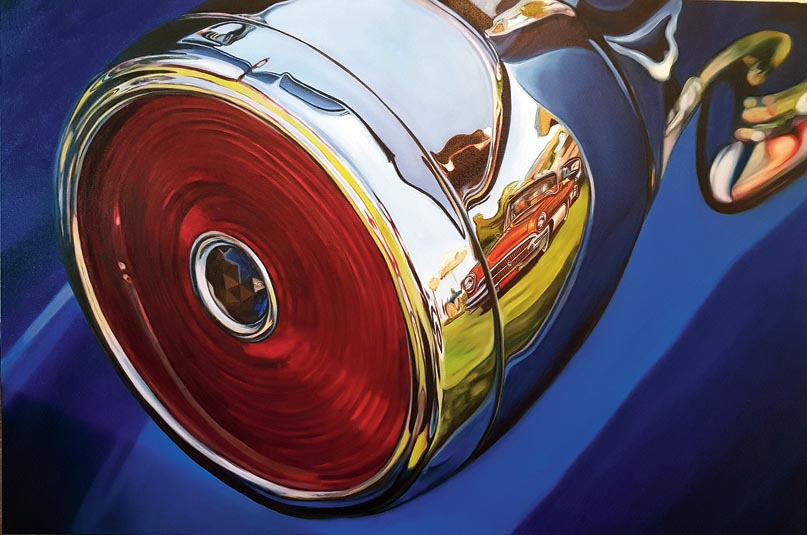
Cadillac tail light Pictures courtesy: Vidita Singh
Do you create other artworks apart from oil on canvas too?
I do a lot of paintings in oil, but I do a lot of charcoal and water colours. So I use these three mediums on and off, depending on whichever car I am drawing.
When is your next show?
Right now it is not concrete, but I do want to exhibit in Mumbai next. I just had my exhibition in February 2020 at the Bikaner House in Delhi. It was a solo show. I am glad I did it right on time before the coronavirus pandemic started here.
So whenever the show in Mumbai happens can we expect anything new from you in terms of change in style or theme.
Well, I do have a few ideas, but I am yet to put them on the canvas. Let’s see.
Exhibitions
2005:
- Featured artist at Autorama, the annual vintage car exhibition held by the Titus & Co. automotive museum, New Delhi
2006:
- Solo exhibition at ABN-AMRO Hauz Khas Art Gallery, New Delhi
2007:
- Exhibited at the Haig Vintage Car Rally, New Delhi
2008:
- Exhibited at the Automotive Exposition, New Delhi
2011:
- Exhibited at the Cartier Concours d’Elegance held in New Delhi
2012:
- Royal Fables Exhibition, held at The Imperial Hotel in New Delhi
2013:
- Royal Fables Exhibition, held in New Delhi
2014:
- Royal Fable Exhibition, held at The Imperial Hotel in Delhi
- Royal Fables Exhibition held at The St. Regis Hotel in Mumbai

Art of the Automobile at Bikaner House,New Delhi Pictures courtesy: Vidita Singh
2016:
- Solo Exhibition in Mumbai at the India Fine Art Gallery
- Royal Fables Exhibition held at Hyatt Regency in New Delhi
- Royal Bridges Art Convergence at Ritz Carlton in Dubai, U.A.E
- Painting auctioned by Christie’s in Dubai, U.A.E
2017:
- Solo Exhibition at Taj Falaknuma, Hyderabad
- Royal Fables Exhibition held at DLF Emporio in New Delhi
- Solo exhibition at the Gold Coast Motor Festival, Hong Kong
2018:
- Automotive Fine Arts Society Exhibition, Pebble Beach Concours d’Elegance, California, US
2019:
- Exhibited at the Taj Rambagh Palace, Jaipur
- Exhibited at Jaipur Art Summit at the Bombay Arts Society, Mumbai
- Exhibited at Mercedes-Benz, Benchmark Cars & Royal Fables, Ahmedabad
2020:
- Solo show Art of the Automobile at Bikaner House,New Delhi

